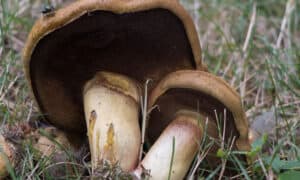Cremini mushrooms go by many names. Many call them champignon mushrooms, others cremini, others button, or even white button. The popular mushroom is one of the easiest to come by in grocery stores, but is not the easiest to grow and almost impossible to forage for.
Let’s take a look at the mushroom in a more logical light. Where to find them, how hard they are to forage for, what they taste like, where they originated, and more.
Classification for Champignon Mushrooms
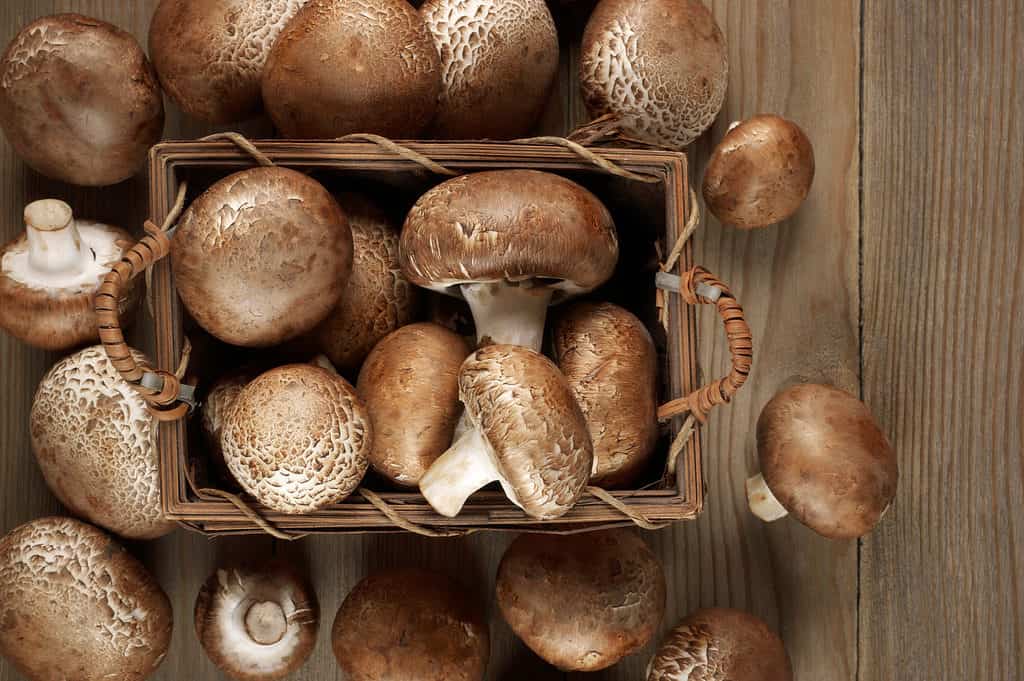
Cremini mushrooms may be sold in white or brown.
©Svetlana Lukienko/Shutterstock.com
Champignon or cremini mushrooms are far from the largest mushrooms you’ll find in the wild, but they’re not tiny either. Cremini mushrooms, or scientifically known as Agaricus bisporus, is on average about 1 to 2 inches in diameter. The mushroom is an edible mushroom that can be found growing in the grasslands of Eurasia and North America. They may be either brown or white before maturity when they are white. The mushroom is one of the most cultivated in the world. It is in high demand but also extremely accessible in most locations. They are part of the Agaricaceae family.
The mushroom goes by many different names, as well, when mature and white in color.
- Cremini mushroom
- Button mushroom
- White button mushroom
- Common mushroom
- White mushroom
- Cultivated mushroom
- Table mushroom
- Champignon (which is French for mushroom)
When they are immature but in the brown colored camp, they may be known as
- Swiss brown mushrooms
- Roman brown mushrooms
- Baby bellas
- Italian brown mushrooms
- Cremini/crimini mushrooms
- Chestnut mushrooms (not to be confused with Pholiota adiposa)
Where Do Cremini Mushrooms Grow?
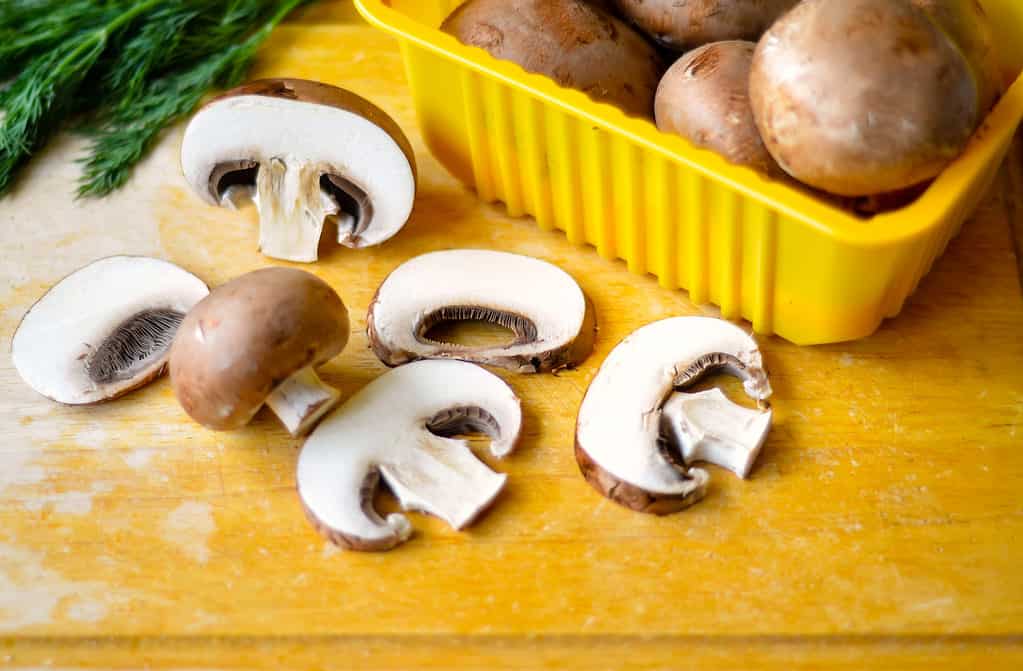
They are one of the most popular mushrooms around the world.
©Tatiana.Sidorova/Shutterstock.com
We know that cremini mushrooms have been growing around the world since prehistoric times. But we don’t fully know where they were first cultivated. It’s likely that they were first made into farmed edibles by ancient Asian cultures, perhaps Japan, Indian, or China. We do know that the mushroom was first cultivated in Europe in the 17th Century. We also know that they cultivated in France in the catacombs of Paris, earning them the moniker “champignons of Paris.” The species is still cultivated underground in western France today. The mushrooms have been cultivated in North America since the 1800s, with at least 50% of the mushrooms of the United States being grown in the state of Pennsylvania.
In the wild, they are found the world over in grassy areas, meadows, fields, and similar locations after rainfall, from late spring into autumn. They are often in pasturelands where animals have offered them manure to derive rich nutrients from.
What Do Champignon Mushrooms Taste Like?
Cremini mushrooms have an earthy flavor that’s what most people probably think of when they think of eating mushrooms. It’s milder than portobello mushrooms, savory, and chewy, or rubbery when raw, with a meaty texture when cooked.
Are Cremini Mushrooms Safe to Eat?
Cremini mushrooms are probably the number one most consumed mushroom in the world. They’re easy to come by, easy to grow, and extremely affordable, so more people are probably familiar with these mushrooms than any other in the world.
How Are Cremini Mushrooms Used?
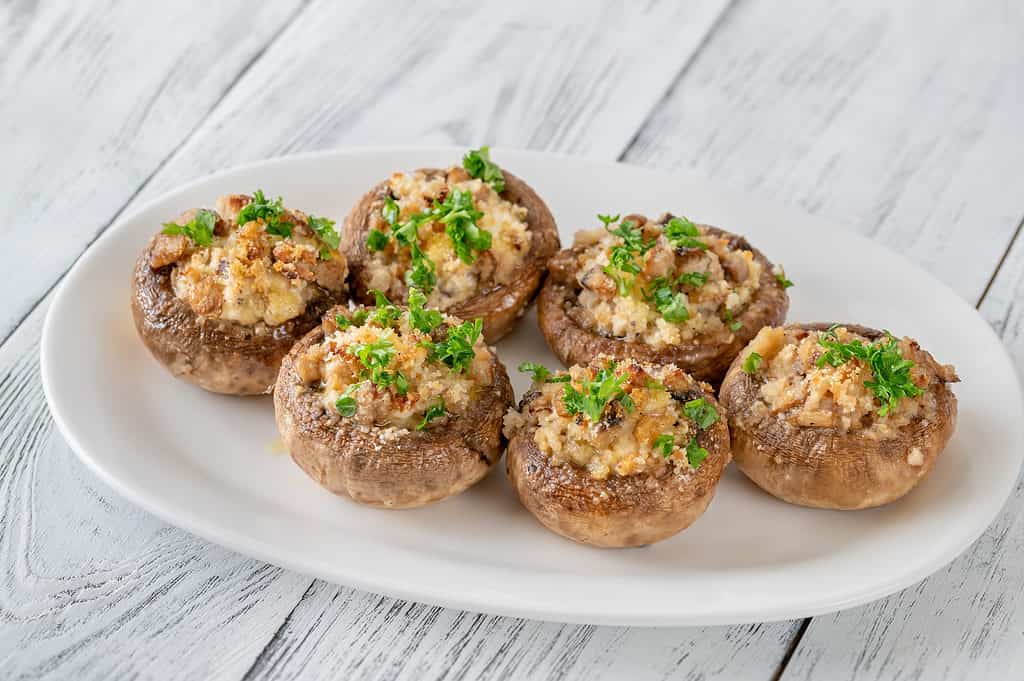
They’re largely used in culinary circles.
©Alexander Prokopenko/Shutterstock.com
This fungi is used primarily for culinary purposes, though they have other uses as well. In cooking, they are often added to stir fry, used to make mushroom sauces, added to pizzas, added to marinara sauces, used to make soup and stew. They’re added to salads and chilis, sauces, grain bowls, rice dishes, stuffed and served as hors devours, paninis, stuffing, and noodle dishes. In the nonculinary realm, the mushrooms are used in skin care products and health supplements.
Health Benefits of Champignon Mushrooms

They come in white or brown.
©BGSmith/Shutterstock.com
A single serving of cremini mushrooms provides the eater with multiple nutrients known to help physical health. They have B vitamins, riboflavin, pantothenic acid, phosphorous, potassium, and fiber. The benefits of these various nutrients are known, however, the amount of health boost from eating mushrooms steadily is still being studied.
Cremini mushrooms are believed to help with fighting off diseases such as cancers (thanks to the antioxidants they contain), prevent and help constipation, relieve stress, reduce risks for heart disease, help with pregnancy-related high blood pressure and diabetes, help the digestive system, lower cholesterol, and help reduce weight gain.
How Much Do Cremini Mushrooms Cost?
Thankfully, champignon mushrooms are one of the most affordable varieties in the world. Since they are extremely well-cultivated, they are available in almost every grocery store in many countries. They typically run less than $5 a pound, making them accessible and useable for most people.
How to Identify Cremini Mushrooms
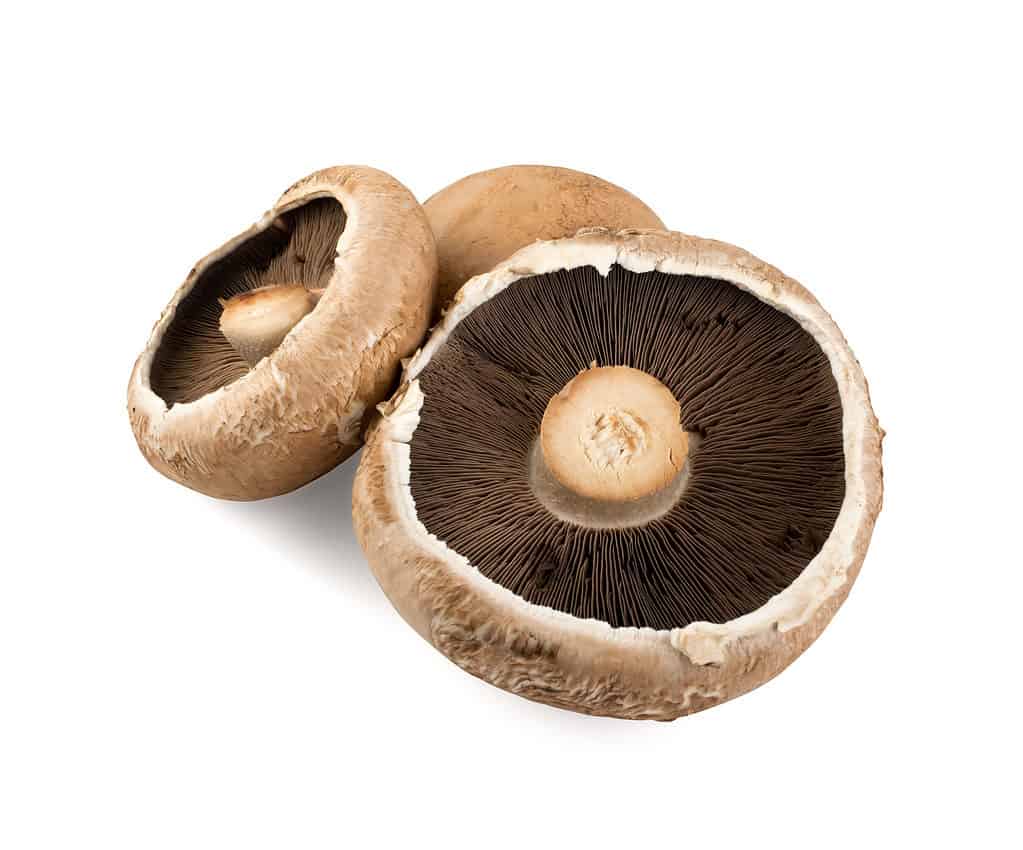
Tight, dark gills are one indicator of the species.
©Ermak Oksana/Shutterstock.com
Champignon mushrooms are recognizable to most of us, however, they have some deadly lookalikes. It’s extremely important to know the differences if you ever choose to forage for these mushrooms.
Champignons or creminis are pretty rare in the wild, so it is probably easier to just buy them. They may have either white or brown caps when they are immature. The brown could be a warm beige brown or a paler creamy brown. The white is often chalky white to pale gray. They have flat scales on paler backgrounds that fade toward the margins. The narrow gills are crowded and start out pink and then become red-brown to dark brown or charcoal brown with an off-white edge. The stems are thick and dense and white. There are many other similar looking Agaricus species out there, some toxic, make sure to stay away from ones that stain yellow or have a phenolic smell.
Creminis have lookalikes that are quite dangerous (deadly), including the famous destroying angel mushroom (Amanita bisporigera and similar), which has a cup at the base of the mushroom and pure white gills instead of the pinkish to brown of cremini mushrooms. There are others, as well, that are less dangerous, including the Agaricus xanthodermus, which also likes to grow in grassy areas. Like mentioned above, they smell a bit like phenol and turn yellow when bruised. These make you sick (nausea and vomiting) but aren’t likely to do permanent damage.
How to Grow Cremini Mushrooms
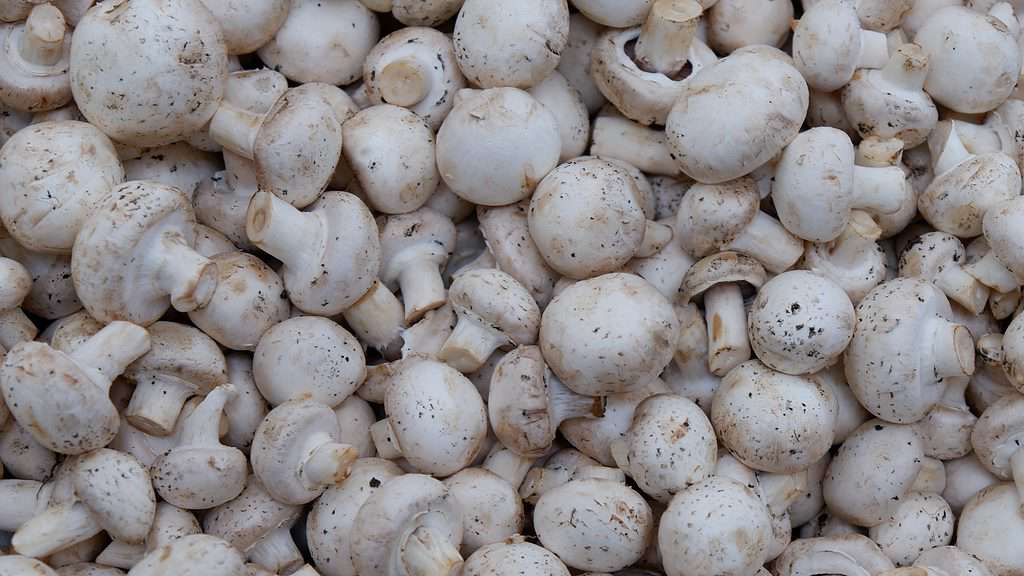
They’re easy to grow!
©Maneki Zeyna/Shutterstock.com
Because there are such dangerous lookalikes for cremini mushrooms, many folks discourage nonexperts from foraging for these mushrooms. Instead, it’s recommended that you buy them or try to grow them at home.
You don’t have to have a dank, dark basement to grow them, promise! Instead, using a grow tent is a great way to grow them.
The easiest way to start is with a cremini mushroom grow kit. The kits come with everything you’ll need to grow them. If you choose to DIY it, though, you’ll need:
- A dark grow tent (i.e., not an indoor greenhouse)
- A box with solid sides, which can be made of metal, plastic, or wood – at least 6 inches deep
- High nitrogen substrate (many use horse manure or a mix of compost and manure)
- Spores or mushroom spawn
- Spray bottle with water
Then:
- Place the box in your grow tent and fill it with the compost/manure substrate mixture.
- Mix the mushroom spores/spawn into the mix, into the top few inches of the substrate.
- Mist the substrate and then close up the grow tent.
- Keep the growing media moist and the whole thing warm until you see many mycelium popping up.
- Lower the temperature of the grow tent and keep it dark. Keep the growing media moist.
- When the caps start to appear, they are ready to harvest.
- For mature mushrooms, let them grow until the caps are white and 1 to 2 inches in diameter.
- Harvest by gently snapping the stems.
Cremini – Button – White Button – Champignon Mushroom Trivia
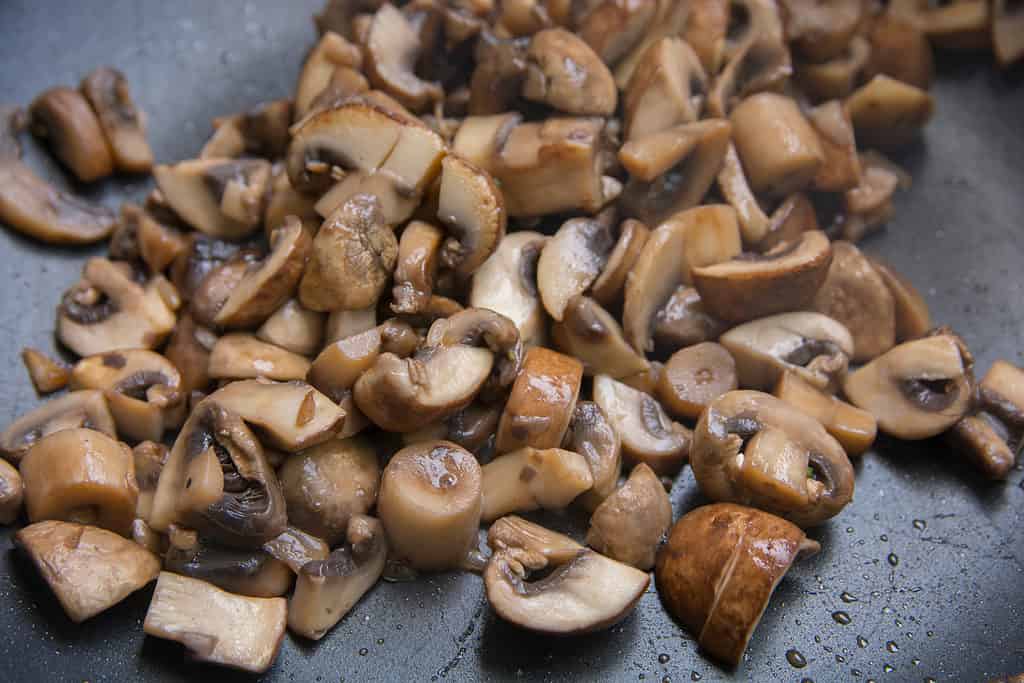
They’re delicious sauteed, but may be eaten raw, as well.
©SingerGM/Shutterstock.com
Button mushrooms have grown wild since before we have written records to tell us about them. They were literally considered “food of the gods” in many cultures (Rome, Russia, Mexico, to name a few) and were believed to imbue the eater with superhuman powers.
The first scientific description of these mushrooms was written by French botanist Joseph Pitton de Tournefort in 1707. The modern commercial varieties of cremini were actually light brown in color, but the white mushroom was discovered in 1925 growing among a bed of brown mushrooms at the Keystone Mushroom Farm in Coatesville, Pennsylvania. The owner brought the mushroom back to his lab and worked to develop the mushroom in this format because of white bread being a recent phenomenon and wildly popular. It was thought white mushrooms would also be more popular than brown. Now, the white button mushroom, as they’re typically labeled in North American grocery stores, account for 90% of the mushrooms sold in the United States.
Up Next:
- Black Trumpet Mushrooms: A Complete Guide
- What is the Best Month for Mushroom Hunting?
- Shaggy Mane Mushrooms: A Complete Guide
- Death Cap Mushrooms: A Complete Guide
The photo featured at the top of this post is © Maneki Zeyna/Shutterstock.com
The information presented on or through the Website is made available solely for general informational purposes. We do not warrant the accuracy, completeness, or usefulness of this information. Any reliance you place on such information is strictly at your own risk. We disclaim all liability and responsibility arising from any reliance placed on such materials by you or any other visitor to the Website, or by anyone who may be informed of any of its contents. None of the statements or claims on the Website should be taken as medical advice, health advice, or as confirmation that a plant, fungus, or other item is safe for consumption or will provide any health benefits. Anyone considering the health benefits of particular plant, fungus, or other item should first consult with a doctor or other medical professional. The statements made within this Website have not been evaluated by the Food and Drug Administration. These statements are not intended to diagnose, treat, cure or prevent any disease.
Sources
- Specialty Produce, Available here: https://specialtyproduce.com/produce/Cremini_Mushrooms_706.php
- Elma Skincare, Available here: https://elmaskincare.com/herbs/herbs_cremini_mushroom.htm
- Happy Sprout, Available here: https://www.happysprout.com/gardening/cremini-mushroom-facts/
- Gro Cycle, Available here: https://grocycle.com/cremini-mushrooms-guide/
- Nature's Produce, Available here: https://naturesproduce.com/encyclopedia/crimini/
- Wikipedia, Available here: https://en.wikipedia.org/wiki/Agaricus_bisporus
- Greatist, Available here: https://greatist.com/health/cremini-mushroom-nutrition
Thank you for reading! Have some feedback for us? Contact the AZ Animals editorial team.



